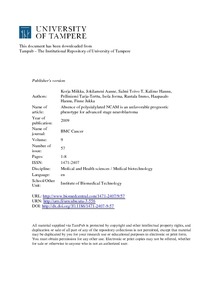Absence of polysialylated NCAM is an unfavorable prognostic phenotype for advanced stage neuroblastoma
Korja, Miikka; Jokilammi, Anne; Salmi, Toivo T; Kalimo, Hannu; Pelliniemi, Tarja-Terttu; Isola, Jorma; Rantala, Immo; Haapasalo, Hannu; Finne, Jukka (2009)
Korja, Miikka
Jokilammi, Anne
Salmi, Toivo T
Kalimo, Hannu
Pelliniemi, Tarja-Terttu
Isola, Jorma
Rantala, Immo
Haapasalo, Hannu
Finne, Jukka
2009
BMC Cancer 9
57
This publication is copyrighted. You may download, display and print it for Your own personal use. Commercial use is prohibited.
Julkaisun pysyvä osoite on
https://urn.fi/urn:nbn:uta-3-556
https://urn.fi/urn:nbn:uta-3-556
Kuvaus
BioMed Central Open access
Tiivistelmä
Background
The expression of a neural crest stem cell marker, polysialic acid (polySia), and its main carrier, neural cell adhesion molecule (NCAM), have been detected in some malignant tumors with high metastatic activity and unfavorable prognosis, but the diagnostic and prognostic value of polySia-NCAM in neuroblastoma is unclear.
Methods
A tumor tissue microarray (TMA) of 36 paraffin-embedded neuroblastoma samples was utilized to detect polySia-NCAM expression with a polySia-binding fluorescent fusion protein, and polySia-NCAM expression was compared with clinical stage, age, MYCN amplification status, histology (INPC), and proliferation index (PI).
Results
PolySia-NCAM-positive neuroblastoma patients had more often metastases at diagnosis, and polySia-NCAM expression associated with advanced disease (P = 0.047). Most interestingly, absence of polySia-NCAM-expressing tumor cells in TMA samples, however, was a strong unfavorable prognostic factor for overall survival in advanced disease (P = 0.0004), especially when MYCN was not amplified. PolySia-NCAM-expressing bone marrow metastases were easily detected in smears, aspirates and biopsies.
Conclusion
PolySia-NCAM appears to be a new clinically significant molecular marker in neuroblastoma, hopefully with additional value in neuroblastoma risk stratification.
The expression of a neural crest stem cell marker, polysialic acid (polySia), and its main carrier, neural cell adhesion molecule (NCAM), have been detected in some malignant tumors with high metastatic activity and unfavorable prognosis, but the diagnostic and prognostic value of polySia-NCAM in neuroblastoma is unclear.
Methods
A tumor tissue microarray (TMA) of 36 paraffin-embedded neuroblastoma samples was utilized to detect polySia-NCAM expression with a polySia-binding fluorescent fusion protein, and polySia-NCAM expression was compared with clinical stage, age, MYCN amplification status, histology (INPC), and proliferation index (PI).
Results
PolySia-NCAM-positive neuroblastoma patients had more often metastases at diagnosis, and polySia-NCAM expression associated with advanced disease (P = 0.047). Most interestingly, absence of polySia-NCAM-expressing tumor cells in TMA samples, however, was a strong unfavorable prognostic factor for overall survival in advanced disease (P = 0.0004), especially when MYCN was not amplified. PolySia-NCAM-expressing bone marrow metastases were easily detected in smears, aspirates and biopsies.
Conclusion
PolySia-NCAM appears to be a new clinically significant molecular marker in neuroblastoma, hopefully with additional value in neuroblastoma risk stratification.
Kokoelmat
- Artikkelit [6140]
